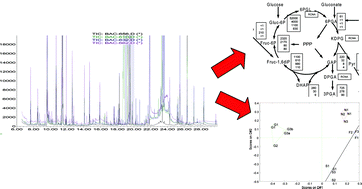Metabolomics is an emerging, powerful, functional genomics technology that involves the comparative non-targeted analysis of the complete set of metabolites in an organism. We have set-up a robust quantitative metabolomics platform that allows the analysis of ‘snapshot’ metabolomes. In this study, we have applied this platform for the comprehensive analysis of the metabolite composition of Pseudomonas putida S12 grown on four different carbon sources, i.e. fructose, glucose, gluconate and succinate.
This paper focuses on the microbial aspects of analyzing comprehensive metabolomes, and demonstrates that metabolomes can be analyzed reliably. The technical (i.e. sample work-up and analytical) reproducibility was on average 10%, while the biological reproducibility was approximately 40%. Moreover, the energy charge values of the microbial samples generated were determined, and indicated that no biotic or abiotic changes had occurred during sample work-up and analysis. In general, the metabolites present and their concentrations were very similar after growth on the different carbon sources. However, specific metabolites showed large differences in concentration, especially the intermediates involved in the degradation of the carbon sources studied. Principal component discriminant analysis was applied to identify metabolites that are specific for, i.e. not necessarily the metabolites that show those largest differences in concentration, cells grown on either of these four carbon sources.
For selected enzymatic reactions, i.e. the glucose-6-phosphate isomerase, triosephosphate isomerase and phosphoglyceromutase reactions, the apparent equilibrium constants (Kapp) were calculated. In several instances a carbon source-dependent deviation between the apparent equilibrium constant (Kapp) and the thermodynamic equilibrium constant (Keq) was observed, hinting towards a potential point of metabolic regulation or towards bottlenecks in biosynthesis routes. For glucose-6-phosphate isomerase and phosphoglyceromutase, the Kapp was larger than Keq, and the results suggested that the specific enzymatic activities of these two enzymes were too low to reach the thermodynamic equilibrium in growing cells. In contrast, with triosephosphate isomerase the Kapp was smaller than Keq, and the results suggested that this enzyme is kinetically controlled.


 Please wait while we load your content...
Please wait while we load your content...